BACK TO THE FUTURE (1985)
A high school student is accidentally sent 30 years into the past in a time-travelling DeLorean, where he meets his parents as teenagers.
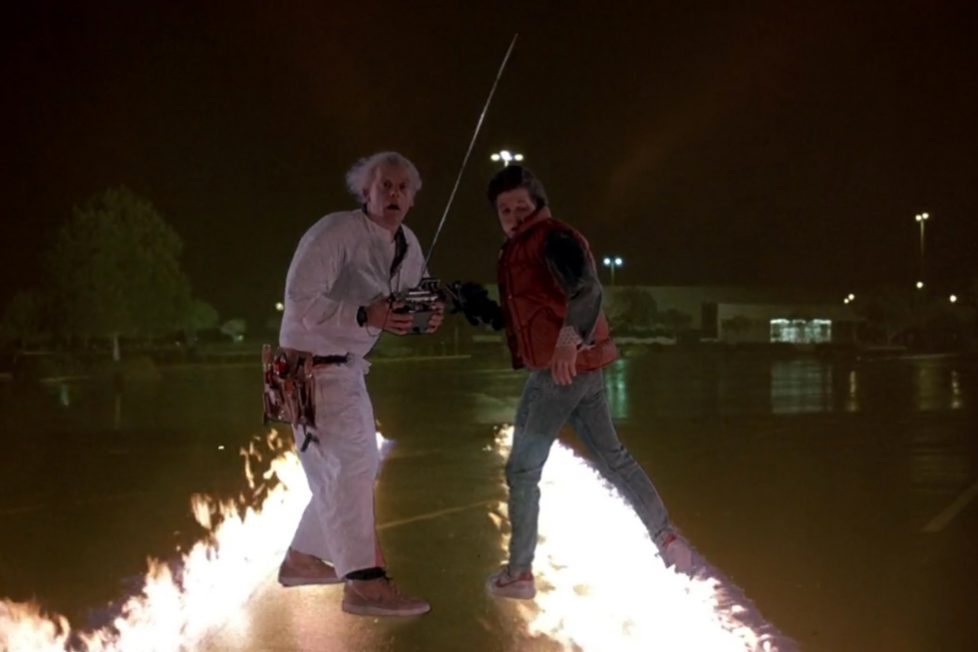
A high school student is accidentally sent 30 years into the past in a time-travelling DeLorean, where he meets his parents as teenagers.


One of the most beloved films of the 1980s, Robert Zemeckis’ Back to the Future has stood the test of time. 35 years since it dominated the summer of 1985, this science-fiction adventure still has passionate fans whose enthusiasm hasn’t dimmed. It’s the high point of a trilogy where good sequels didn’t sour its memory, and it’s avoided being remade because everyone knows that’s a pointless exercise. Back to the Future exhibits perfect filmmaking alchemy, albeit with one setback involving the lead actor…
The genesis of Back to the Future began around 1980 when screenwriter Bob Gale, who had just produced and co-written Used Cars (1980) with his friend Robert Zemeckis, found his parent’s high school yearbook in their basement. He wondered if he’d have been friends with his own father in high school, and after telling Zemeckis about his find they started to imagine the dramatic possibilities of discovering your own mother and father were very different people in their younger days.
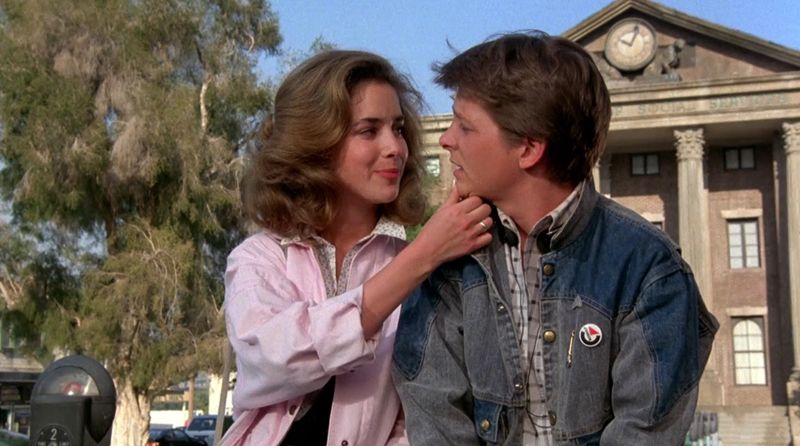
The only way to make the concept work had to involve time-travel of some form, but the concept was always driven by down-to-earth familial concerns. It would have to take place during the 1950s for mathematical reasons if their time-traveller was going to be a 17-year-old, which just so happened to be the decade when the “teenager” was created. The ’50s was a period of huge cultural shifts in music and attitudes in the young, paving the way for the sexual revolution of the 1960s, so Gale and Zemeckis developed an idea where a teen from 1985 would use a time-travelling refrigerator to go back to 1955 and help his shy father woo his beautiful mother. The complication? He accidentally becomes his father’s love rival for his mother’s affections.
In 1981, a first draft was written and shopped around various studios, but executives thought it lacked sexuality. Adjustments were made during a period when teen movies like Fast Times at Ridgemont High (1982) were becoming popular, but then Disney rejected it for being too risqué because a mother kisses her own son. Over the years, the time-travelling refrigerator idea was also abandoned because Zemeckis worried kids mimicking the film could get trapped inside their own kitchen appliances! Having a time machine that was mobile would also prove advantageous for the plot, so the idea of using a DMC DeLorean sports car (a notorious disaster in the US market) was arrived at because it looked suitably futuristic for a joke where a ’50s farmer mistakes it for a flying saucer.
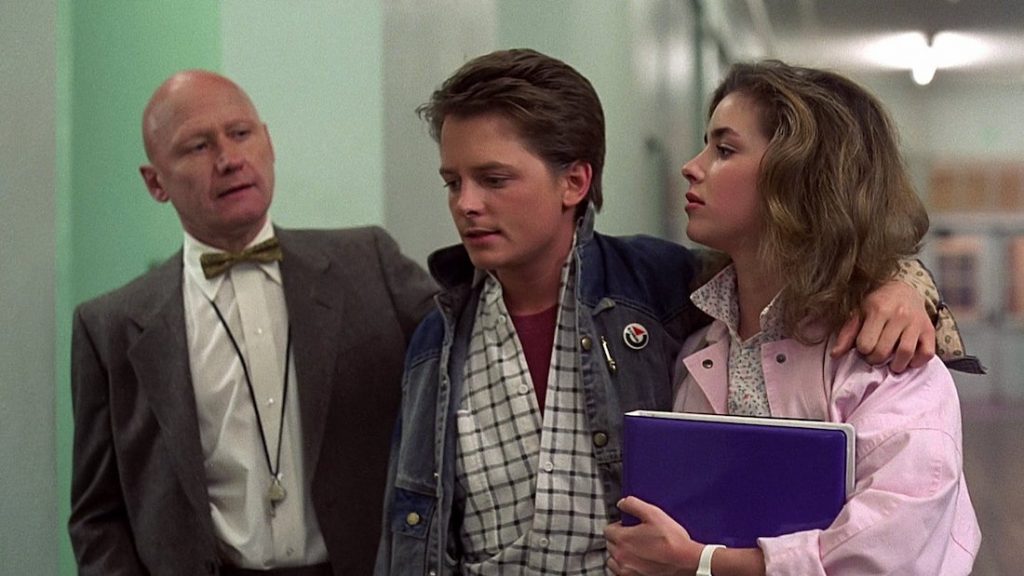
Zemeckis was close friends with Steven Spielberg, who had produced his Beatles movie I Wanna Hold Your Hand (1978) and Used Cars, but when both flopped at the box office he was hesitant to involve Spielberg in the development process of Back to the Future. He didn’t want to become known as an unsuccessful filmmaker who only got projects made because he could pull favours with the genius behind Jaws (1975) and Raiders of the Lost Ark (1980), so he instead went off and directed Romancing the Stone (1984). Luckily, Stone was a big hit (costing $10M it grossed $115M), and with this newfound kudos, Zemeckis approached Spielberg to parlay his success into getting Back to the Future produced by his company Amblin Entertainment.
Universal Studios agreed to distribute the film now it had Spielberg’s blessing, with executive Sidney Sheinberg suggesting a few name changes to the script: Meg McFly became Lorraine McFly (after his own wife Lorraine Gary), and Professor Brown became Doc Brown. Fine changes, we all agree, but he also inexplicably wanted to change the title to Space Man from Pluto! Zemeckis was horrified by this studio note, but Spielberg famously wrote to Sheinberg with the subtext everyone had assumed his suggestion was a tongue-in-cheek joke. Scheinberg didn’t want to look foolish by confirming he was being serious, so the title change was never mentioned again. Universal also didn’t want to pay for the written climax where the DeLorean drives through a nuclear bomb test in the Nevada Desert to recharge its time circuits to get back to ’85, so the ending was wisely adjusted to keep the set-piece within the confines of Hill Valley.
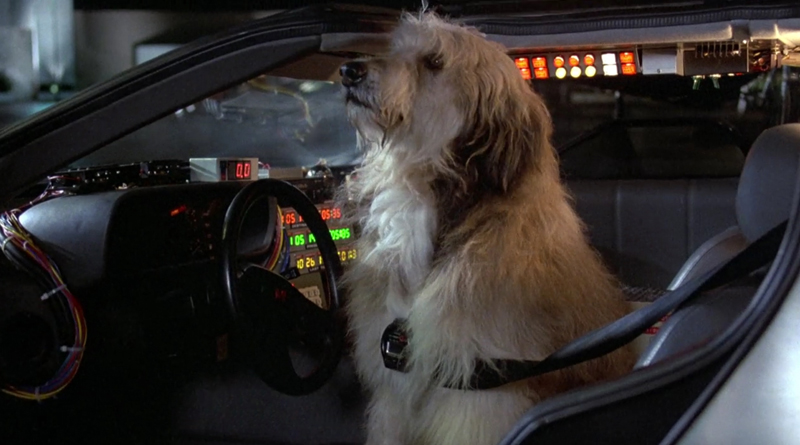
Of course, the most notorious difficulty Back to the Future faced came when cameras started rolling in November 1984. Michael J. Fox had been the first choice to play Marty McFly, but he was committed to filming the sitcom Family Ties, so they instead went with actor Eric Stoltz after previewing his excellent performance in Mask (1985). However, five weeks into filming and Zemeckis was becoming convinced Stoltz had been miscast. The young actor was bringing an intensity to the part that clashed with the lighthearted adventure story he was in, and the cast and crew were finding Stoltz’s method acting process difficult to handle. For example, he insisted on being called ‘Marty’ while on-set. Zemeckis confided in Spielberg and they both agreed to find another actor who could handle the comedic aspects of the role better, accepting this setback would add $3M to the $14M budget to redo everything they’d already shot with Stoltz.
The search was back on to find a new Marty McFly! So attention naturally returned to Michael J. Fox, who had already read and loved the script because he could identify with Marty’s attitude and interests. Family Ties producer Gary David Goldberg didn’t want to lose Fox during a difficult period on his show when his co-star Meredith Baxter was on maternity leave, but he agreed to allow Fox the chance to work on Back to the Future during any downtime he had—with the understanding Family Ties would take priority every time there was a scheduling clash. Everyone agreed to these terms and Fox was on-set in January filming Stoltz’s scenes with co-star Christopher Lloyd (as Doc Brown). Lloyd himself was the second choice for this part, as John Lithgow had been unavailable, but luckily his madcap performance turned out to be exactly right for an eccentric inventor. He apparently based the character on Albert Einstein and composer Leopold Stokowski.
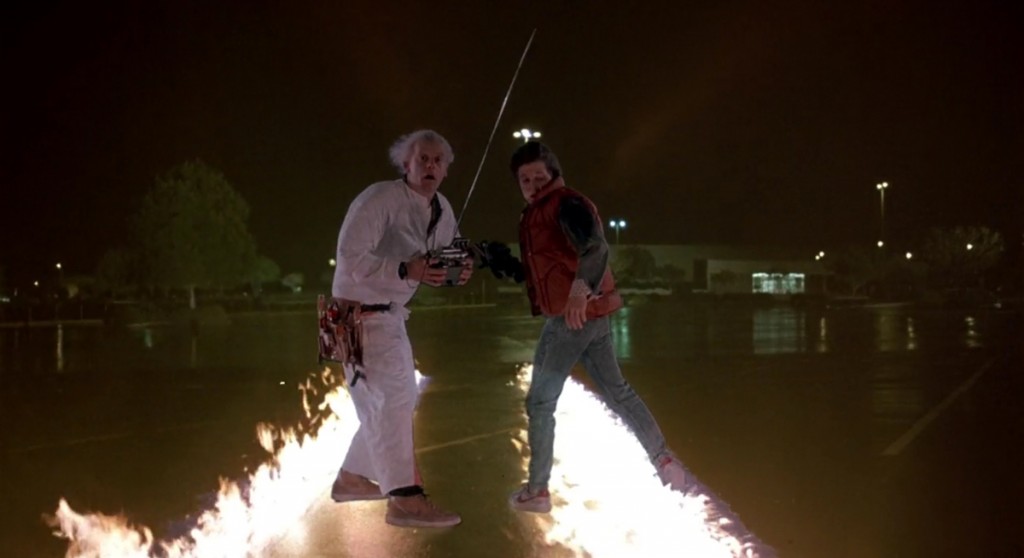
Other actors involved were, of course, Lea Thompson as Lorraine Baines McFly, who got the role partly because she’d shared the screen with Stoltz in The Wild Life (1984); newcomer Thomas F. Wilson as bully Biff Tannen (actor J.J Cohen had been the first choice, but got demoted to playing one of Biff’s goons because he wasn’t imposing enough); Claudia Wells as Marty’s girlfriend Jennifer (a late replacement for Melora Hardin, who couldn’t continue in the role because she was too tall opposite Fox); and Crispin Glover as Marty’s father George McFly, whose bizarre performance wasn’t exactly what Zemeckis had envisioned, but you can’t deny he left an impression!
Universal couldn’t agree on terms for Glover to return for the two sequels, so he was recast with Jeffrey Weissman in Back to the Future: Part II (1989) and they recycled old footage of him, which prompted Glover to sue the studio for using his likeness without permission. Zemeckis and Glover only patched thing up a few decades later, ahead of working on Beowulf (2007).
Principal photography took 100 days, wrapping on 20 April 1985. Fox was understandably exhausted because he was shooting Family Ties in the day then heading to the Back to the Future set for weekday night shoots, meaning he only averaged five hours of sleep each day. Daytime scenes could only be shot at the weekends. The iconic Courthouse Square backlot was used as the fictional Hill Valley, which was a familiar exterior used most notably in The Twilight Zone’s first episode and as Kingston Falls in Gremlins (1984). The producers decided to use a fake town because no real-life location would allow them to extensively redecorate every shopfront to resemble the mid-1950s for three months.
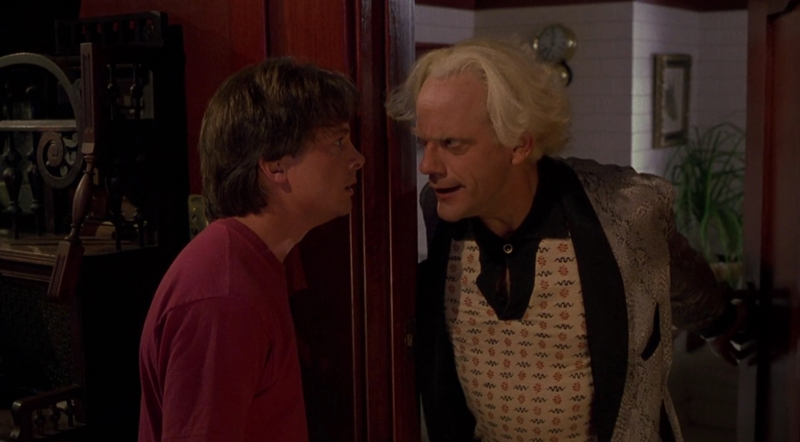
Once filming was over, Back to the Future’s planned May release was pushed back to August until a test screening audience reacted positively to an unfinished cut. Spielberg was encouraged to instead get the film ready for 3 July 1985, making it a major summer release, so quickly hired two editors and had a team of sound editors work 24-hour shifts in order to meet this date. ILM handled the 32 VFX shots required (a paltry figure by modern standards), and composer Alan Silvestri was hired to write the music after working with Zemeckis on Romancing the Stone. He created one of cinema’s best theme tunes for the film and even suggested Huey Lewis and the News write the theme song—which became “The Power of Love”, a track that dominated radio playlists and became synonymous with the film.
Back to the Future premiered on 3 July without Fox around to promote it (as he was in London shooting a Family Ties special), but it became the biggest hit of the summer, grossing $389M worldwide and enjoying widespread critical acclaim. The 1986 VHS release even added a ‘To Be Continued…’ tag to the ending, confirming expectations that a sequel would be made to answer the thrilling cliffhanger.

Entrenched as a modern classic years later, thanks in no small part to repeated airplay on TV ever since, Back to the Future remains a childhood favourite of mine that refuses to date. And for a movie about time and differing eras, it’s fascinating to see how people’s relationship to the story has evolved. In 1985, Marty’s trip to the ’50s was a hit of pure nostalgia for a larger portion of the adult audience watching, but even the youngsters were aware of that era’s rich heritage because sitcoms like Happy Days were still popular.
Today, 1985 is more distant for us than 1955 was for Marty, and the ’50s is practically an alien culture for millennials… but none of that matters. It’s arguably more alluring to watch Back to the Future now its ’80s-ness holds an equal amount of nostalgia for many. And it’s a fascinating period for American kids wanting to know what their parents and now grandparents lived through. And for non-Americans, there’ll always be a magical feel to the innocence of the US back in the mid-’50s, when everything about the country seemed so colourful and optimistic.
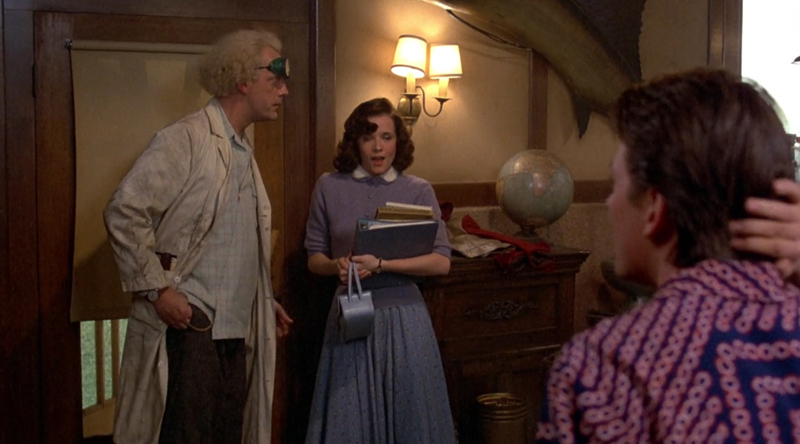
But the real magic behind Back to the Future lies with the beautiful story and likeable characters. You even love-to-hate Biff, who became the archetypical meathead school bully for years. If a similar film was made today, it would probably resemble the flashier sequels on steroids, with numerous jumps around in time encountering dinosaurs and Egyptian pharaohs. But it’s worth remembering how the time-travel element of the original was purely a mechanism to allow the real story to unfold; the tale of a teenage slacker scared of public rejection playing wingman to his goofy father to help woo his glamorous mum, in order to ensure the course of true love doesn’t go awry and erase his own existence. And during the process, he manages to give his doormat dad a backbone and get over his rejection issues by playing rock n’ roll to a big crowd.
There’s naturally a lot of fish-out-of-water comedy involving Marty having to adjust to the naive ’50s society, while accidentally giving folk a taste of the future—inventing the skateboard and rock n’ roll along the way. But there are also excellent parallels between the two era’s of Hill Valley (an idea the sequels continued with the 21st-century and the Old West), and it’s all capped by the wonderful chemistry between Michael J. Fox and Christopher Lloyd. Their rapport is legendary, making you forget it’s weird a popular teenager like Marty hangs around with a middle-aged bachelor inventor and plutonium thief! (Perhaps Marty just couldn’t resist the supersized amps Doc would build for him?) It’s strange how things have changed since the ’80s, as you rarely see movies where young characters interact with adults who aren’t family. Whatever happened to cross-generational friendships, Hollywood?
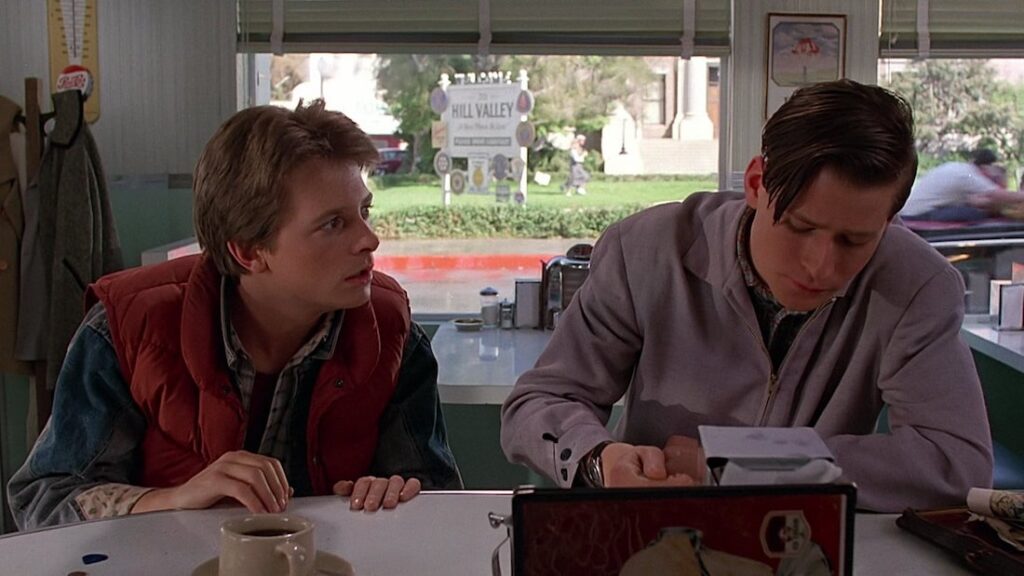
The film is also crammed with jokes and streams of quotable lines, some of which became catchphrases within the trilogy itself. I’ve seen Back to the Future countless times (and keep buying it on every home video format), but I’m still discovering little things about it! As a kid in the mid-’80s, I only picked up on so much about the basics of what was going on in the story, but as my awareness of the world expanded some of its jokes became clearer and more subtleties started to be noticed. It was only within the past 15 years I realised Twin Pines Mall has been renamed Lone Pine Mall once Marty returns to ’85, as the Delorean destroyed one of the two pine trees when Marty first went back in time. It rewards repeated viewings!
Back to the Future has an enthralling high-concept populated by likeable characters, and every creative choice turned out to be on-point—from the choice of a gull-winged Delorean (now as associated with time-travel as a TARDIS) to the recasting of Michael J. Fox in what became his signature role. Who talks about Family Ties nowadays? A special mention must also go to Lea Thompson, who has third-billing but often gets forgotten about because the characters around her are more proactive and larger-than-life. But she’s fantastic in a dual role as a crabby middle-aged mom (with admittedly patchy make-up), perfectly juxtaposed by her character’s youthful sweetness in ’55. It’s a tribute to both her and Fox that the potential ickiness of their character’s relationship is never distastefully handled, just amusingly awkward as the falls in love with mysterious stranger “Calvin Klein”.
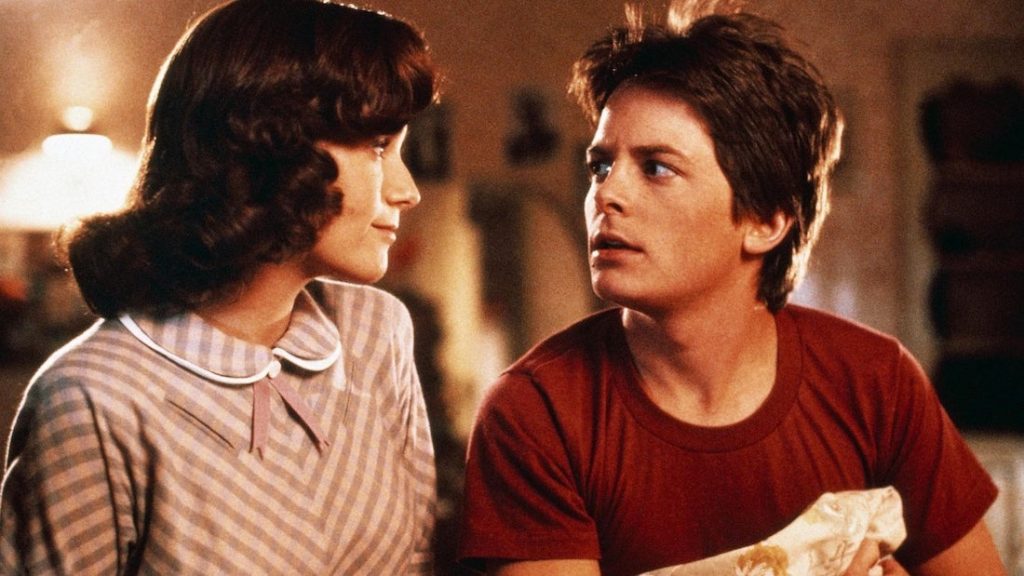
The script is drum-tight with no wasted scenes and it’s always a joy to be swept along in the fun of what’s ultimately a peculiar love story. And whenever the film needs to broaden its horizons away from Marty playing Cupid, Zemeckis’ filmmaking is sublime during the more action-oriented sequences. The climactic set-piece around Hill Valley’s Clock Tower is a masterful example of action choreography and precision editing, with Doc Brown dangling from the clockface in a nod to Harold Lloyd in Safety Last! (1923), desperately trying to connect it to wires running across the street in order to zap the DeLorean back to the future the nanosecond lightning strikes. I never fail to get tense when the DeLorean’s engine cuts out and risks Doc’s meticulously calculated plan failing, leaving Marty forever stranded in history.
Back to the Future is a story that refuses to show its age. It’ll be enjoyed for decades to come by generations yet unborn, even as the story’s two time periods become increasingly distant. And that’s because everyone can relate to the idea of hanging out with your parents when they were adolescents and don’t know you yet. It’s an imaginative leap we all take when leafing through old family photos, and Back to the Future makes that dream an exciting reality for a few hours. Plus there’s a rendition of “Johnny Be Good” that’ll never stop being a good time at the movies.
USA | 1985 | 116 MINUTES | 1.85:1 | COLOUR | ENGLISH

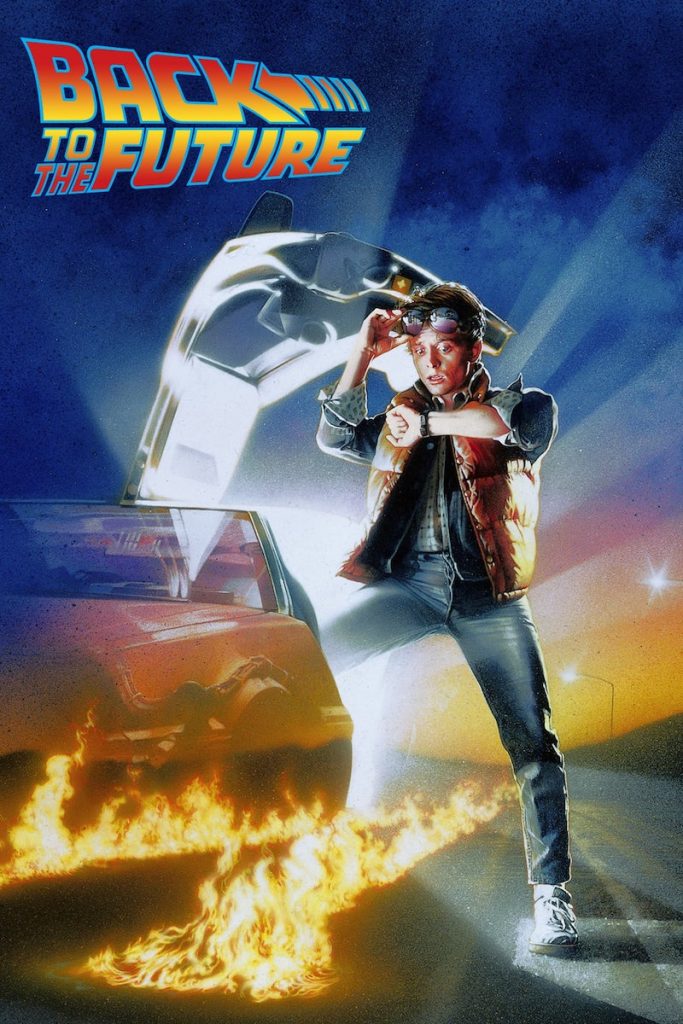
director: Robert Zemeckis.
writers: Robert Zemeckis & Bob Gale.
starring: Michael J. Fox, Christopher Lloyd, Lea Thompson, Crispin Glover, Thomas F. Wilson.
